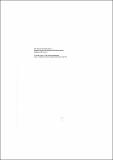| dc.contributor.author | Ensminger, Jean | |
| dc.date.accessioned | 2011-12-09T16:46:06Z | |
| dc.date.available | 2011-12-09T16:46:06Z | |
| dc.date.issued | 1987-12 | |
| dc.identifier.citation | Ensminger, Jean (1987) Institutional change and the quality of life: two decades of economic transformation in a rural community. Working paper no. 455, Nairobi: Institute for Development Studies, University of Nairobi | en_GB |
| dc.identifier.uri | https://opendocs.ids.ac.uk/opendocs/handle/20.500.12413/1314 | |
| dc.description.abstract | This study utilizes insights from the new institutional economics to understand the endogenous demand the Orma are suddenly experiencing for institutional change. A number of factors in their environment have created pressure for new contractual arrangements and new property rights, which in turn have necessitated that the Orma draw upon the institutional resources of the national government to provide third party monitoring and enforcement. According to the theory, if such institutional change does indeed lead to decreased transaction costs for the Orma and more efficient allocation of economic resources, the stage could be set for a period of economic growth, even in the absence of technological change. As such processes are undoubtedly underway in many other societies all over the developing world, this study should have important general implication for economic development.
What makes this an unusual case study is the existence of a large quantitative database for the period just before the most recent institutional changes. Together with the restudy, these data will afford the rare opportunity not only to document the extent of changes in production, consumption, and social structure, but to actually measure their impact upon the quality of life of the population. As there appears to be widespread ideological support for the institutional changes, it proposed that they have benefitted a large sector of the population. The analysis will provide specific data on the extent to which this holds for all subsectors of the population and all measures of the quality of life. The data will also indicate the strength of specific relationships between important economic, nutritional and health variables, thus allowing government policy planners to more effectively allocate scarce resources to social services. | en_GB |
| dc.language.iso | en | en_GB |
| dc.publisher | Institute for Development Studies, University of Nairobi | en_GB |
| dc.relation.ispartofseries | Working Papers.;455 | |
| dc.rights.uri | http://creativecommons.org/licenses/by-nc-nd/3.0/ | en_GB |
| dc.subject | Economic Development | en_GB |
| dc.title | Institutional change and the quality of life: two decades of economic transformation in a rural community | en_GB |
| dc.type | Series paper (non-IDS) | en_GB |
| dc.rights.holder | Institute for Development Studies, University of Nairobi | en_GB |
| dc.identifier.blds | 14103 | |


